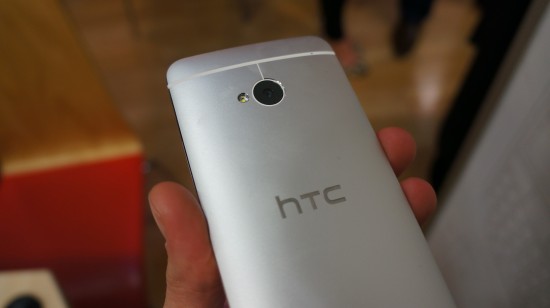Around this time last year HTC unveiled its flagship of 2012, the HTC One X, but the Taiwanese manufacturer is now turning its attention to its next generation smartphone which comes in the form of the HTC One.
The HTC One X was a hugely popular device right from the moment it hit the shelves, but thanks to a helping of new features and innovation the firm hopes its latest offering has what it takes emulate this success.
Here are the HTC One’s specs stacked up against those of the One X to show how far the company’s smartphone technology has developed over the last 12 months.
| Features | HTC One | HTC One X |
| Display | 4.7-inch full 1080p HD (468ppi) | 4.7-inch Super LCD 720p HD (312ppi) |
| Processor | 1.7GHz quad-core | 1.5GHz quad-core |
| Operating System out of the box | Android Jelly Bean | Android Ice Cream Sandwich |
| Camera | HTC UltraPixel | 8 megapixel with ImageSense |
| Front-Facing Camera | 2.1 megapixel | 1.3 megapixel |
| Video Recording | 1080p | 1080p and 720p |
| Internal Storage | 32GB/64GB storage options | 16GB/32GB storage options |
| RAM | 2GB | 1GB |
| Battery | 2,000mAh | 1,800mAh |
| Weight | 143g | 130g |
Design
The unibody chassis associated with HTC has been brought forward to the HTC One, although its matte, aluminium backplate marks a departure from the One X which featured a tough yet glossy, plastic chassis.
The lack of plastic instantly makes the HTC One feel more premium and it’s great to see the slightly curvaceous form-factor and rounded corners make a return on HTC’s new flagship.
The firm has historically been adept when it comes to creating stylish, premium-looking handsets, and the ergonomics of both devices ensure the HTC One and One X sit comfortably in the hand. That said, the HTC One weighs in at 13g heavier than the One X, something you really notice when holding the handset for long periods of time.
Hardware
When the HTC One X launched during Mobile World Congress 2012, it was one of a raft of new handsets boasting a quad-core processor. Its 1.5GHz CPU and 1GB of RAM makes for stutter-free gaming and video playback.
The processor in the One X also carries 4+1 technology, meaning a small fifth core is built onto the chip to preserve battery life when carrying out more menial digital tasks.
Thanks to a 1.7GHz quad-core processor and 2GB of RAM the HTC One is even more powerful and ensures features such as the all new ‘Blink Feed’ homescreen (more on this later) runs without so much as a hitch, as well as allowing for seamless multitasking.
Operating system/ user interface
HTC’s latest offering comes with Android Jelly Bean out of the box, but an update is now available to boost the Ice Cream Sandwich OS on the One X to Jelly Bean.
Both handsets see HTC’s Sense user interface skinned on top of Google’s mobile platform, and it’s been given a revamp for the HTC One. HTC Sense 5.0 brings the all new ‘Blink Feed’ feature which pulls realtime updates from media sources and social networks together on to the flipboard-style homescreen.
Display
The impressive 4.7-inch full 1080p HD display on the HTC One features a staggering 468ppi, one of the highest ever seen on a smartphone.
While the One X also has a 4.7-inch display the lower pixel count means the two handsets are leagues apart. The sharp visuals and bright colours seen on the HTC One, particularly when taking pictures and reading your favourite blogs, puts HTC’s latest offering at the top of the smartphone pile when it comes to stunning displays.
Camera
The 8 megapixel lens on the HTC One X features ImageSense camera technology which is utilised in features such as an auto adjusting flash and quick focus.
On board the One X there’s the innovative dual-capture mode which allows users to take pictures while recording a video. Editing options to adjust elements such as the exposure and contrast of an image are also included.
Although it produces good results, images can sometimes be distorted affecting the level of detail captured within a shot, especially in low-light settings. To avoid flaws like this on the HTC One the manufacturer has introduced its new UltraPixel camera for the first time.
Although the sensor is only 4 megapixels, HTC has used a larger sensor which allows more light to pass through, making for crisper and more detailed images, banishing blur and unwanted shadows.
An extra helping of innovation has also been built into the camera app in the form of HTC Zoe; a function which instead of capturing an image, records a three second video clip from which users can then pull out different frames for editing. An abundance of editing options are also available, allowing users to do things such as remove unwanted objects from a shot to create the perfect picture.
Verdict
There is no doubt that the One X is a very good handset thanks to its ample display, powerful processor and sleek design. But, over the past 12 months HTC has built on this level of functionality and bought new innovations to the fore to ensure the HTC One is its best handset to date.
It’s the only ‘One’ branded device scheduled for release this year, but it’s certainly a unique proposition that promises to keep the brand’s strong heritage going and pave the way for even more advancements in its future smartphone technology.





